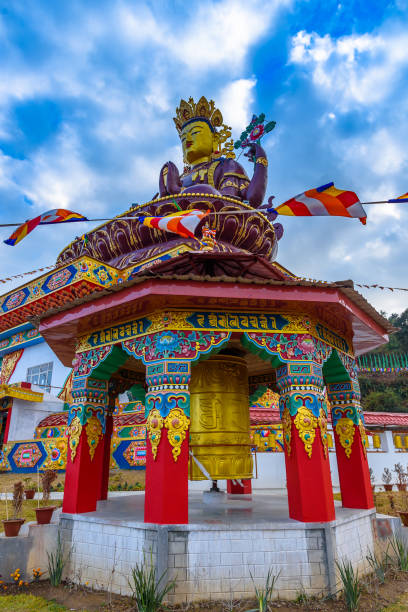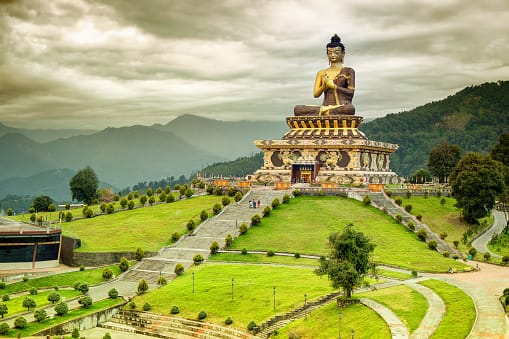Sikkim is a small state nestled in the eastern Himalayas of India. It is known for its stunning natural beauty, snow-capped mountains, alpine forests, and picturesque landscapes. The state is also rich in cultural heritage and boasts a diverse and vibrant culture that has evolved over centuries.
The Sikkimese people are a mix of different ethnic groups, including the Lepchas, Bhutias, and Nepalis. Each community has its own unique customs and traditions, but they share a common bond and live in harmony with each other.
The Lepchas are the indigenous people of Sikkim and have a rich cultural heritage that dates back centuries. They are known for their traditional attire, which consists of a long-sleeved shirt and a wrap-around skirt for women, while men wear a loose-fitting shirt and trousers. The Lepchas also have their own language, which is spoken by a small number of people today.
The Bhutias are another ethnic group in Sikkim, and they have a strong Tibetan influence in their culture. They are known for their colorful attire, which includes a woolen coat called a chuba, and a scarf called a khaden. The Bhutias are also skilled in handicrafts such as weaving, painting, and wood carving.
The Nepali community is the largest ethnic group in Sikkim and has had a significant influence on the state’s culture. Nepali is the most widely spoken language in Sikkim and is also the state’s official language. The Nepali people are known for their colorful festivals and dances, including the famous Nepali dance form, the Maruni.
One of the most important festivals in Sikkim is the Losar festival, which is celebrated by the Tibetan and Bhutia communities. It marks the Tibetan New Year and is a time for family gatherings, feasting, and religious ceremonies. The festival is celebrated with great fervor and includes traditional dances, music, and rituals.
Another popular festival in Sikkim is the Bumchu festival, which is celebrated by the Lepcha community. It is a unique festival that involves filling a sacred vessel with water and predicting the future based on the water level. The festival is an important part of Lepcha culture and is celebrated with great enthusiasm.
Sikkim is also home to many monasteries, which are an integral part of the state’s cultural heritage. The Rumtek monastery is one of the most famous monasteries in Sikkim and is considered to be one of the holiest in the world. It is the seat of the Karmapa, the head of the Karma Kagyu school of Tibetan Buddhism.
The monasteries in Sikkim are not just places of worship but also centers of learning and culture. They are adorned with intricate murals and frescoes that depict Buddhist deities and symbols. The monasteries also hold traditional dance performances and festivals that attract visitors from all over the world.
Sikkim is also known for its traditional music and dance forms. The Gha To Kito and Singhi Chaam are two popular dance forms in Sikkim that are performed during festivals and cultural events. The Gha To Kito is a Lepcha dance that involves drumming and singing, while the Singhi Chaam is a Bhutia dance that depicts the victory of good over evil.
Sikkim’s cuisine is also unique and reflects the state’s diverse cultural heritage. The cuisine is a blend of Tibetan, Nepali, and Indian flavors and includes dishes such as momos, thukpa, and gundruk. Momos are steamed dumplings filled with meat or vegetables, while thukpa is a noodle soup that is popular in the Himalayan region. Gundruk
Sikkim Travel Guide.
Discovering the Best of Sikkim: Top 5 Places to Visit in the Himalayan State”
Sikkim is a state in northeastern India that is known for its breathtaking natural beauty, rich cultural heritage, and adventure sports. Nestled in the Himalayas, this small state offers a diverse range of attractions to tourists, including scenic vistas, trekking trails, hot springs, and ancient monasteries. In this article, we will explore Sikkim travel and tourism, highlighting five major places to visit.
Gangtok
Gangtok is the capital city of Sikkim and one of the most popular tourist destinations in the state. Situated at an altitude of 5,410 feet, Gangtok offers panoramic views of the Himalayas, including the world-famous Kanchenjunga peak. Visitors can explore the city’s bustling markets, sample local delicacies, and visit the famous Enchey Monastery and Rumtek Monastery, both of which are important centers of Tibetan Buddhism. Gangtok also serves as a base for exploring nearby attractions such as the Nathula Pass and the Tsomgo Lake.

Pelling
Pelling is a small town located in the western part of Sikkim. Known for its stunning views of the Kanchenjunga peak and the surrounding valleys, Pelling is a popular destination for trekkers and nature lovers. Visitors can explore the town’s ancient monasteries, including the Pemayangtse Monastery, which dates back to the 17th century and is one of the oldest and most important monasteries in Sikkim. Pelling is also home to the Khecheopalri Lake, which is considered sacred by both Buddhists and Hindus.

Lachung
Lachung is a picturesque village located in the northern part of Sikkim. Surrounded by snow-capped mountains and pristine forests, Lachung is a great place to experience the natural beauty of Sikkim. Visitors can explore the village’s traditional houses, sample local cuisine, and take part in adventure activities such as trekking and river rafting. Lachung is also famous for its hot springs, which are said to have healing properties.


Yuksom
Yuksom is a historic town located in the western part of Sikkim. Known as the “Gateway to Kanchenjunga,” Yuksom is a popular destination for trekkers who want to explore the Kanchenjunga National Park. Visitors can also explore the town’s historic monasteries and temples, including the Dubdi Monastery, which dates back to the 17th century and is the oldest monastery in Sikkim. Yuksom is also home to the Khangchendzonga National Park, which is a UNESCO World Heritage Site.

Ravangla
Ravangla is a small town located in the southern part of Sikkim. Surrounded by lush green forests and tea plantations, Ravangla is a great place to relax and enjoy the natural beauty of Sikkim. Visitors can explore the town’s historic monasteries, including the Ralong Monastery and the Doling Monastery. Ravangla is also a popular destination for adventure sports such as paragliding and rock climbing.
In addition to these five destinations, Sikkim has many other attractions that are worth visiting. These include the Namchi Monastery, the Tashi Viewpoint, the Gurudongmar Lake, and the Yumthang Valley. Visitors can also take part in adventure sports such as trekking, river rafting, and mountain biking.
Sikkim is also known for its rich cultural heritage. The state has a unique blend of Nepalese, Tibetan, and Indian cultures, which is reflected in its art, architecture, and cuisine.
“


